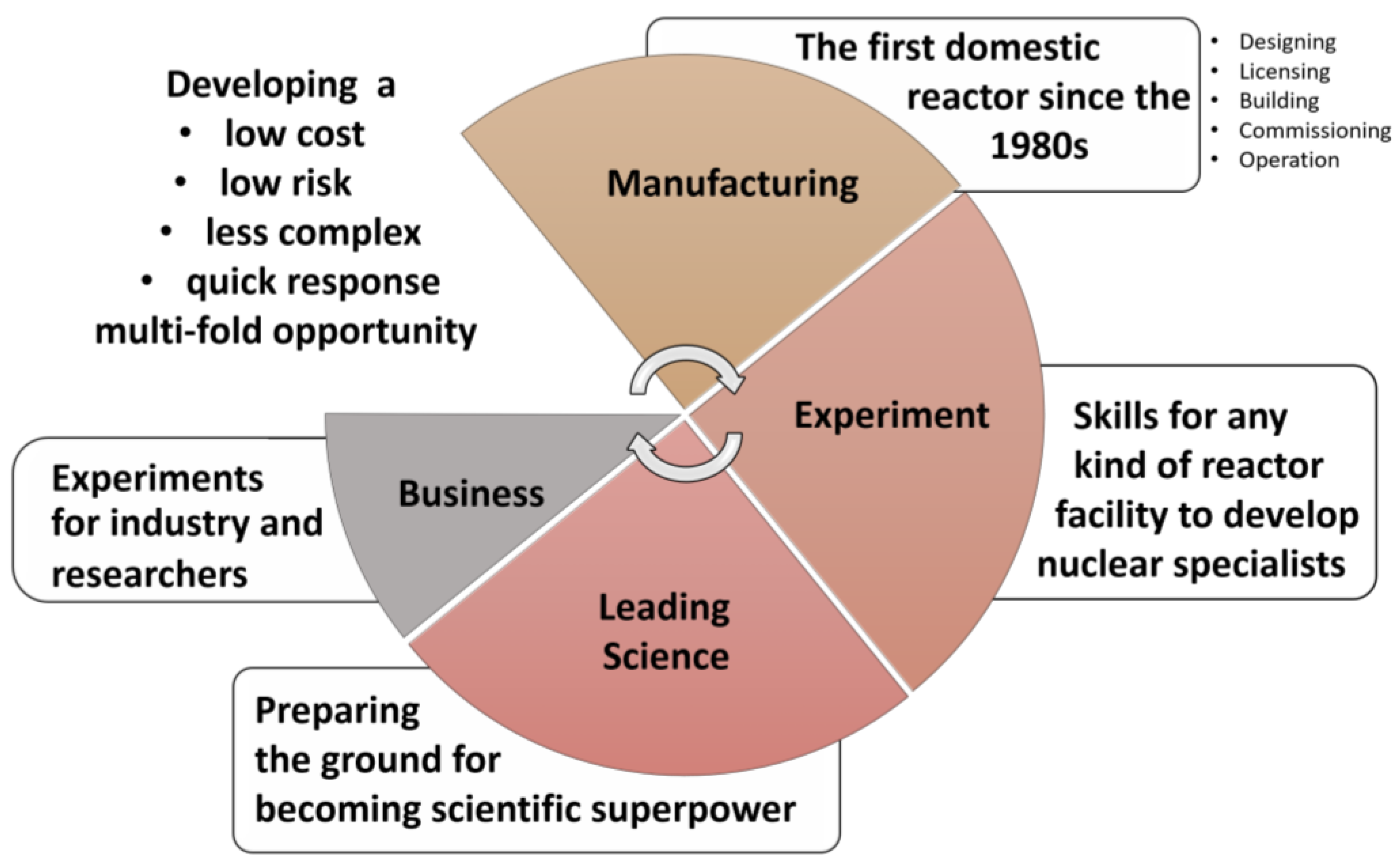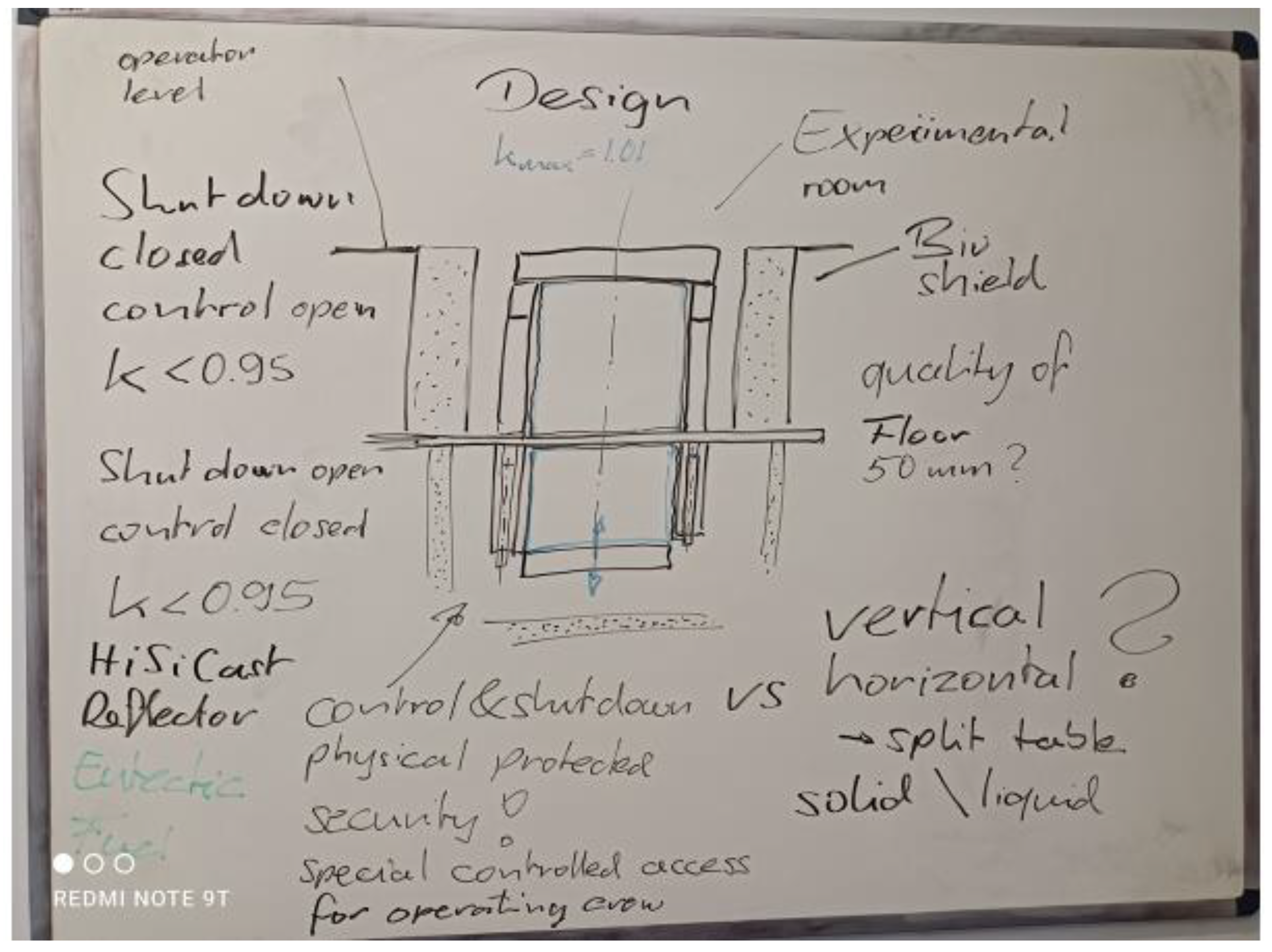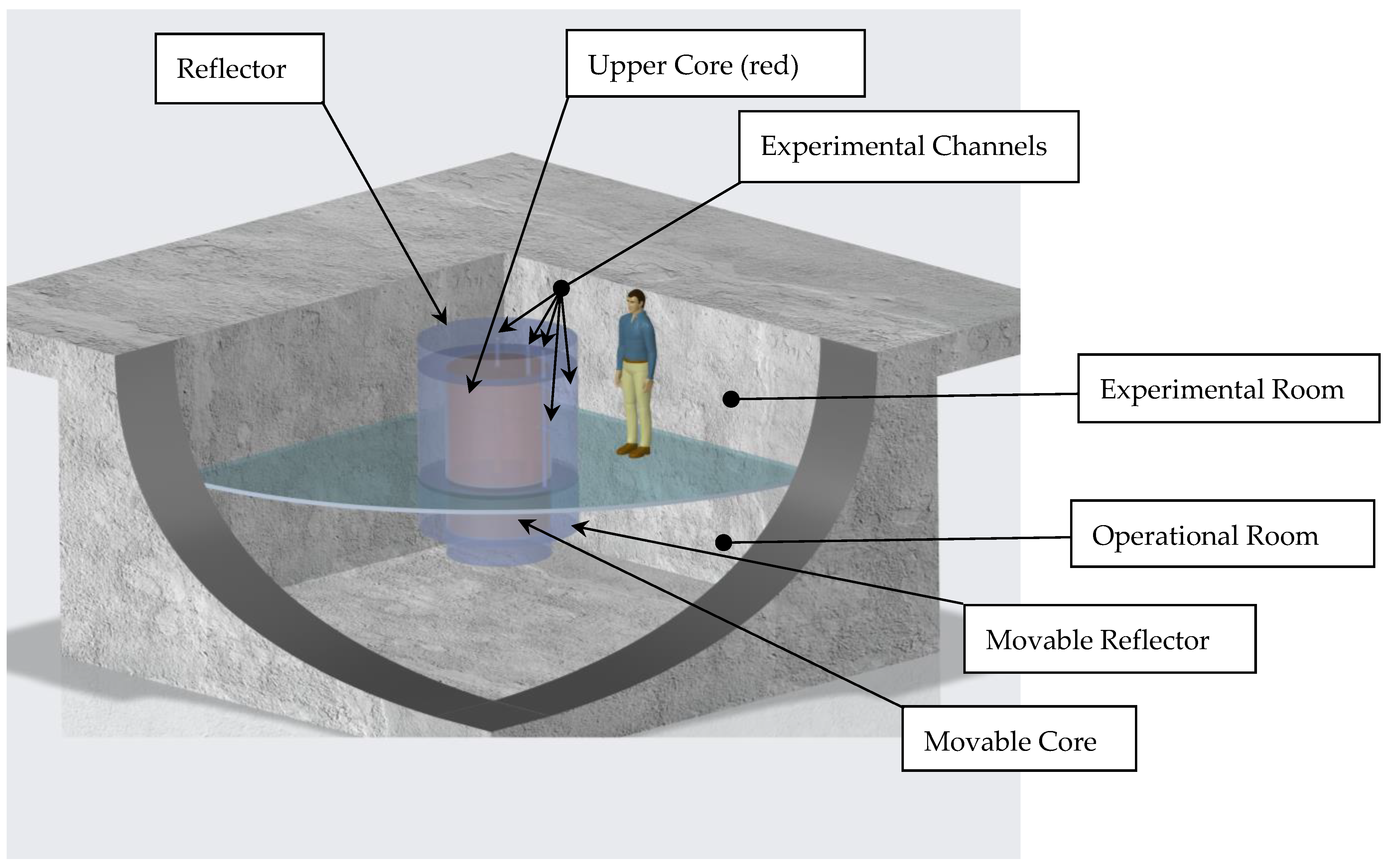A Draft Design of a Zero-Power Experiment for Molten Salt Fast Reactor Studies
Abstract
1. Introduction
1.1. What Characterises a Zero-Power Experimental Facility?
- ▪
- Multi-purpose facility;
- ▪
- Small-scale experiment;
- ▪
- Low-power system (<10 kW);
- ▪
- Room-temperature operation;
- ▪
- No requirement of a dedicated heat removal system;
- ▪
- Negligible power-induced reactivity feedback;
- ▪
- Negligible burnup and poisoning due to fission products;
- ▪
- No new fuel requirements after the initial core loading;
- ▪
- Reduced safety challenges due to the elimination of dedicated heat removal systems;
- ▪
- Low-radiation-level system;
- ▪
- Highly accessible system;
- ▪
- Flexible reactor operation;
- ▪
- Flexible adjustment of experimental conditions according to the validation criteria/requirements.
- ▪
- Core criticality;
- ▪
- Neutron flux, energy and power distribution;
- ▪
- Reactivity coefficients;
- ▪
- Changes in reactivity and flux as a function of salt density, temperature and composition change (in case of molten salt reactors);
- ▪
- Kinetic parameters such as the Rossi-Alpha;
- ▪
- Safety-relevant effects (shutdown through core drainage).
1.2. Opportunities
2. Approach to the Problem
2.1. Facility/Core Design
2.2. Core Control
- A.
- Increasing the absorption of neutrons through the addition of neutron absorbers into the core, like the insertion of control rods into a reactor core, or the addition of boron into the coolant of a light water reactor.
- B.
- Increasing the leakage of neutrons through removing a part of the neutron reflector which helps scatter back neutrons into the core. This technique has also been proposed for small-sized reactors like space reactors through the use of control drums which can combine reflecting and absorbing properties [19].
- C.
- Decreasing the fission source by removing fuel from the core through the use of control rods with a combination of an absorber and a fuel follower. When the control rod is removed, the fuel follower moves into the core adding fissile material, and when the control rod is inserted, the fuel follower moves out of the core reducing the amount of fuel in the core. This approach has been used in some reactors in the past to increase the efficiency of the control system [20]. In addition, this effect has been studied in the core disassembly phase in sodium-cooled fast reactors [21], and it is used in some small education and teaching reactors like AKR-2 where the core is split into two halves for the shutdown [22].
- D.
- Changing the neutron spectrum into energies with lower fission cross-sections and increased leakage. This approach can be particularly interesting in thermal reactors where the hardening of the neutron spectrum though the removal of the moderator can significantly reduce the fission reaction rate. As a side effect, the neutron leakage also increases. This approach is possible in heavy water-moderated reactors through moderator drainage [23], or it can be seen as a natural phenomenon occurring during a large break loss of coolant accident when all of the moderator has been pushed out of the core.
- Applicability—is the proposed method compatible with the system? For example, the insertion of an absorber like boron into the moderator works only in a system with a liquid moderator like that for PWRs or PHWRs.
- Sufficient margin—does it provide sufficiently large changes? For example, the control system has to be powerful enough to compensate the reactivity changes during a full cycle of an LWR.
- Sufficient sensibility—does it provide the sensibility needed for experiments? For example, for any reactor experiment, it is essential to be able to measure the critical steady-state operational point with enough precision even after small changes in the core.
- Agility of action—does it act quickly enough in a transient? For example, several passively acting shutdown systems have been proposed for fast reactors, but their actuation time is not sufficient to avoid accident progression.
- Moving mass—can the engineering challenges be handled? For example, a large component like a reflector or a part of the core could be too heavy to be moved precisely and quickly; thus, the splitting of the core has only been used in very small cores until now.
- Disturbing the homogeneity—does it cause perturbations in the surroundings of the measurements? For example, if experiments in a homogenous material configuration will be required, the local insertion of control rods could have strong influence on the experimental outcome.
- In-core control or shutdown absorber rod [principle A];
- Moving the radial reflector up or down [principle B];
- Splitting the core [principle B and C];
- Absorber rod/drum in the reflector [principle B];
- Moving the rod with reflector material in the reflector [principle B];
- Core drainage—only in the liquid state [principle C];
- Moving axial reflector [principle B];
- Inserting/removing the rod of fuel inside the core [principle C].
2.3. Currently Foreseen Experimental Programme
- ▪
- ▪
- ▪
- Neutron flux, energy and power distribution
- ▪
- Reactivity coefficients
- ▪
- Changes in reactivity and flux as a function of salt density, temperature and composition change
- ▪
- Kinetic parameters such as the Rossi-Alpha [28]
- ▪
- Potentially safety-relevant effect studies
- ▪
- Potential additional experimental opportunities
3. Potential Core Design
- A split core design with a movable lower part (indicated through the blue frame and the blue arrows to visualize the potential movement) as the shutdown mechanism—the share of the core has to be determined based on regulatory requirements with the first objective being to achieve k ≤ 0.95.
- A moving reflector or parts of the reflector—the choice has to be confirmed through modelling and simulation depending on the achievable versus the requested control margin and sensitivity.
- Both parts of the core separated through a stainless steel floor to exclude the possibility of the upper part accidently dropping onto the lower part when the core is in a shutdown configuration.
- A core arranged in two separate rooms, one for the experimental crew conducting experiments and the other for operational, control and shutdown systems. Such a physical separation of the operational and experimental areas will ensure that operational areas can be access-controlled, while the experimental hall is more easily accessible for different experimental teams as well as equipment manipulation.
- A high-silicon cast iron reflector has been chosen based on its suitable performance amongst different reflector materials investigated earlier [13] as well as for the ease of manufacturing.
- Vertical in the centre of the core;
- Vertical at the core periphery;
- Vertical in the reflector;
- Horizontal at the top of the core;
- Horizontal in the centre of the core.
4. Conclusions
Author Contributions
Funding
Data Availability Statement
Conflicts of Interest
References
- British Nuclear Revival to Move towards Energy Independence. Available online: https://www.gov.uk/government/news/british-nuclear-revival-to-move-towards-energy-independence (accessed on 8 December 2023).
- Nuclear Power in a Clean Energy System, IEA Report. Available online: https://iea.blob.core.windows.net/assets/ad5a93ce-3a7f-461d-a441-8a05b7601887/Nuclear_Power_in_a_Clean_Energy_System.pdf (accessed on 8 December 2023).
- At COP28, Countries Launch Declaration to Triple Nuclear Energy Capacity by 2050, Recognizing the Key Role of Nuclear Energy in Reaching Net Zero. Available online: https://www.energy.gov/articles/cop28-countries-launch-declaration-triple-nuclear-energy-capacity-2050-recognizing-key (accessed on 8 December 2023).
- Profiling the Top Nuclear Power Pros and Cons. Available online: https://www.nsenergybusiness.com/features/newstop-nuclear-power-pros-and-cons-5760814/ (accessed on 8 December 2023).
- A Workshop on the Development of a Liquid-Salt Reactor was Held at the MCC. Available online: https://sibghk.ru/news/9068-na-gkhk-proshlo-rabochee-soveshchanie-po-voprosu-sozdaniya-zhidkosolevogo-reaktora.html?_x_tr_sl=ru&_x_tr_tl=en&_x_tr_hl=en-GB (accessed on 16 January 2023).
- Groves, L.R. Now it Can Be Told—The Story of the Manhattan Project; Harper: New York, NY, USA, 1962. [Google Scholar]
- Merk, B.; Litskevich, D.; Detkina, A.; Cartland-Glover, G.; Atkinson, S.; Bankhead, M. A Zero-power Facility as a Multi-fold Opportunity to Support Quick Progress in Innovative Reactor Developments. ATW—Int. J. Nucl. Power 2021, 66, 59–64. [Google Scholar]
- Merk, B.; Detkina, A.; Litskevich, D.; Patel, M.; Noori-kalkhoran, O.; Cartland-Glover, G.; Efremova, O.; Bankhead, M.; Degueldre, C. A First Step towards Zero Nuclear Waste—Advanced Strategic Thinking in Light of iMAGINE. Energies 2022, 15, 7209. [Google Scholar] [CrossRef]
- Merk, B.; Detkina, A.; Noori-kalkhoran, O.; Jain, L.; Litskevich, D.; Cartland-Glover, G. New Waste Management Options Created by iMAGINE through Direct Operation on Spent Nuclear Fuel Feed. Energies 2023, 16, 7420. [Google Scholar] [CrossRef]
- IAEA Research Reactor Database (RRDB). Available online: https://nucleus.iaea.org/rrdb/#/home (accessed on 8 December 2023).
- Merk, B.; Detkina, A.; Atkinson, S.; Litskevich, D.; Cartland-Glover, G. On the Dimensions Required for a Molten Salt Zero Power Reactor Operating on Chloride Salts. Appl. Sci. 2021, 11, 6673. [Google Scholar] [CrossRef]
- Merk, B.; Detkina, A.; Atkinson, S.; Litskevich, D.; Cartland-Glover, G. Innovative Investigation of Reflector Options for the Control of a Chloride-Based Molten Salt Zero-Power Reactor. Appl. Sci. 2021, 11, 6795. [Google Scholar] [CrossRef]
- Merk, B.; Detkina, A.; Atkinson, S.; Litskevich, D.; Cartland-Glover, G. Evaluating Reactivity Control Options for a Chloride Salt-Based Molten Salt Zero-Power Reactor. Appl. Sci. 2021, 11, 7447. [Google Scholar] [CrossRef]
- Billebaud, A. GUINEVERE: Construction of a Zero-Power Pb Fast ADS at Mol. Available online: https://www-pub.iaea.org/MTCD/publications/PDF/P1433_CD/datasets/presentations/SM-ADS-08.pdf (accessed on 15 April 2024).
- Dioni, L.; Jacqmin, R.; Sumini, M.; Stout, B. On the possible use of the MASURCA reactor as a flexible, high-intensity, fast neutron beam facility. In Proceedings of the EPJ Web of Conferences, Bruges, Belgium, 11–16 September 2016; Volume 146, p. 03023. [Google Scholar]
- Merk, B.; Litskevich, D.; Peakman, A.; Bankhead, M. IMAGINE—A Disruptive Change to Nuclear or How Can We Make More Out of the Existing Spent Nuclear Fuel and What Has to be Done to Make it Possible in the UK? ATW-Int. J. Nucl. Power 2019, 64, 353–359. [Google Scholar]
- Nuclear Physical Facility “Yalina”. Available online: https://sosny.bas-net.by/en/technologies/yalina (accessed on 8 March 2024).
- Baeten, P.; Aït Abderrahim, H.; Aoust, T.; Bergmans, G.; Heyse, J.; Maes, D.; Verboomen, B.; Vermeersch, F.; Vittiglio, G. The GUINEVERE project at the VENUS facility. In Proceedings of the International Conference on Physics of Reactors 2008: PHYSOR 08, Interlaken, Switzerland, 14–19 September 2008; pp. 2867–2873. Available online: https://www.proceedings.com/10098.html (accessed on 15 April 2024).
- Schriener, T.M.; El-Genk, M.S. Reactivity control options of space nuclear reactors. Prog. Nucl. Energy 2009, 51, 526–542. [Google Scholar] [CrossRef]
- Ryzhov, S.B.; Mokhov, V.A.; Nikitenko, M.P.; Bessalov, G.G.; Podshibyakin, A.K.; Anufriev, D.A.; Gado, J.; Rohde, U. VVER-Type Reactors of Russian Design. In Handbook of Nuclear Engineering; Cacuci, D.G., Ed.; Springer: Boston, MA, USA, 2010. [Google Scholar] [CrossRef]
- Kamiyama, K.; Saito, M.; Matsuba, K.-I.; Isozaki, M.; Sato, I.; Konishi, K.; Zuyev, V.A.; Kolodeshnikov, A.A.; Vassiliev, Y.S. Experimental study on fuel-discharge behaviour through in-core coolant channels. J. Nucl. Sci. Technol. 2013, 50, 629–644. [Google Scholar] [CrossRef]
- Training Reactor AKR-2, Description of the Reactor Facility Procedure of Operation. Available online: https://tu-dresden.de/ing/maschinenwesen/ifvu/wket/ressourcen/dateien/akr2/Lehrmaterialien/aufbau_e.pdf?lang=en (accessed on 17 January 2024).
- Dupleac, D. Analysis of CANDU6 reactor station blackout event concomitant with moderator drainage. U.P.B. Sci. Bull. Series C 2016, 78, 285–292. [Google Scholar]
- Davey, W.G.; Redman, W.C. Techniques in Fast Reactor Critical Experiments; Gordon and Breach: New York, NY, USA, 1970. [Google Scholar]
- Holcomb, D.E.; Kisner, R.A.; Cetiner, S.M. Instrumentation Framework for Molten Salt Reactors; No. ORNL/TM-2018/868; Oak Ridge National Lab. (ORNL): Oak Ridge, TN, USA, 2018.
- Hashemi-Tilehnoee, M.; Javidkia, F. Improving the performance of the power monitoring channel. In Nuclear Reactors; IntechOpen: Rijeka, Croatia, 2012. [Google Scholar]
- Tagziria, H.; Hansen, W. Neutron spectrometry in mixed fields: Proportional counter spectrometers. Radiat. Prot. Dosim. 2003, 107, 73–93. [Google Scholar] [CrossRef] [PubMed]
- Williams, M.M.R. Random Processes. In Nuclear Reactors, 1st ed.; Pergamon Press: Oxford, UK, 1974. [Google Scholar]
- Pakari, V. Experimental and Numerical Study of Stochastic Branching Noise in Nuclear Reactors. PhD Thesis, Swiss Federal Institute of Technology EPFL, Lausanne, Switzerland, 2020. [Google Scholar]
- Uhrig, R.E. Noise Analysis in Nuclear Systems. In Noise Analysis in Nuclear Systems; US Atomic Energy Commission, Division of Technical: Washington, DC, USA, 1964. [Google Scholar]
- Prince, B.E.; Ball, S.J.; Engel, J.R.; Haubenreich, P.N.; Kerlin, T.W. Zero-Power Physics Experiments on The Molten-Salt Reactor Experiment; No. ORNL-4233; Oak Ridge National Lab.: Oak Ridge, TN, USA, 1968.
- The Demise of Zero Power Reactors: Addressing Reduced Experimental Capabilities. Available online: https://www.oecd-nea.org/jcms/pl_83239/the-demise-of-zero-power-reactors-addressing-reduced-experimental-capabilities (accessed on 26 February 2024).
- Jain, L. Design of Shutdown and Control Systems for a Zero Power Experiment for Chloride-based Molten Salt Fast Reactors. PLOS ONE 2024. to be submitted. [Google Scholar]



Disclaimer/Publisher’s Note: The statements, opinions and data contained in all publications are solely those of the individual author(s) and contributor(s) and not of MDPI and/or the editor(s). MDPI and/or the editor(s) disclaim responsibility for any injury to people or property resulting from any ideas, methods, instructions or products referred to in the content. |
© 2024 by the authors. Licensee MDPI, Basel, Switzerland. This article is an open access article distributed under the terms and conditions of the Creative Commons Attribution (CC BY) license (https://creativecommons.org/licenses/by/4.0/).
Share and Cite
Merk, B.; Noori-kalkhoran, O.; Jain, L.; Aflyatunova, D.; Jones, A.; Powell, L.; Detkina, A.; Drury, M.; Litskevich, D.; Viebach, M.; et al. A Draft Design of a Zero-Power Experiment for Molten Salt Fast Reactor Studies. Energies 2024, 17, 2678. https://doi.org/10.3390/en17112678
Merk B, Noori-kalkhoran O, Jain L, Aflyatunova D, Jones A, Powell L, Detkina A, Drury M, Litskevich D, Viebach M, et al. A Draft Design of a Zero-Power Experiment for Molten Salt Fast Reactor Studies. Energies. 2024; 17(11):2678. https://doi.org/10.3390/en17112678
Chicago/Turabian StyleMerk, Bruno, Omid Noori-kalkhoran, Lakshay Jain, Daliya Aflyatunova, Andrew Jones, Lewis Powell, Anna Detkina, Michael Drury, Dzianis Litskevich, Marco Viebach, and et al. 2024. "A Draft Design of a Zero-Power Experiment for Molten Salt Fast Reactor Studies" Energies 17, no. 11: 2678. https://doi.org/10.3390/en17112678
APA StyleMerk, B., Noori-kalkhoran, O., Jain, L., Aflyatunova, D., Jones, A., Powell, L., Detkina, A., Drury, M., Litskevich, D., Viebach, M., & Lange, C. (2024). A Draft Design of a Zero-Power Experiment for Molten Salt Fast Reactor Studies. Energies, 17(11), 2678. https://doi.org/10.3390/en17112678







